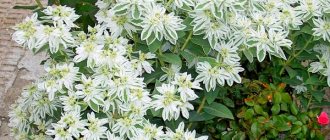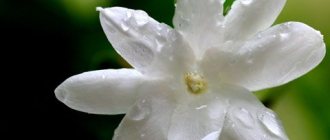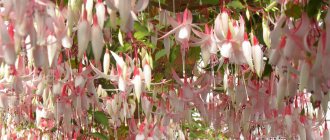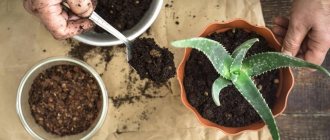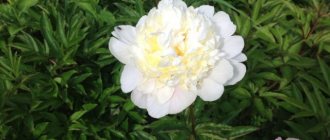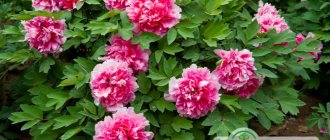Its huge bloody buds with their open cups look more like poppies, and the fluffy openwork foliage resembles the leaves of daisies or dill. The thin-leaved peony is beautiful precisely because of its special, natural charm, and is a rare plant protected by law. And even though it is inferior to varietal peonies in the originality of the structure and color of the flowers, it does not become less decorative because of this. Connoisseurs of classical cultures will appreciate its unpretentious character, fluffy foliage, and graceful buds.
Thin-leaved peony: origin story
Peony thin-leaved (narrow-leaved) is the result of the work of breeders. It grows in the Balkan Peninsula, Eastern Europe, Crimea and the Caucasus.
This flower is not like other varieties because it has a large number of small leaves. Externally, the bush resembles a small Christmas tree with a blossoming bud.
Below are the distinctive features of thin-leaved peony:
- bush height no more than 60 cm;
- leaves are trifoliate-pinnate, dissected into linear and filiform;
- a powerful root system on which there are oblong, cone-shaped neoplasms;
- the flowers are large, shades from red to purple, up to 10 buds can be located on one plant at the same time;
- one inflorescence contains up to 200 golden-colored stamens;
- buds are smooth, double or semi-double;
- all flowers open at the same time, and the flowering period is no more than 12 days.
Important. In the store, this type of peony can be sold under the names: Voronets, Azure Flower, Voronok, Red Lazorik.
The flower is considered unpretentious, so some gardeners add it to their flower beds, while others, because of the dense foliage, do not want to see it in their dacha.
Choosing a landing site
If several conditions are met, even an inexperienced gardener will be able to not only grow, but also maintain the life of the plant for a long time.
The soil should not be soggy so that the rhizomes do not rot. The exception is the period of bud formation; at this time the plant should be watered abundantly. It is important that the soil is not acidic; thin-leaved peony will not take root in such an environment. To do this, the soil must be alkalized with mineral fertilizers, or lime, or wood ash. A 10-15 cm layer of drainage, for example, small stones, gravel, broken bricks, should be placed in the hole of the planting pit. The thin-leaved peony loves moisture, but suffers and quickly dies from stagnation of moisture at the roots.
Peony thin-leaved
Peony thin-leaved should be planted in a well-lit area; it feels great in the shade, but it is still worth spending most of the time in the sun. The planting site should be protected from drafts and strong winds; the plant should not be planted in an open area, but perhaps in a corner of the garden. From an aesthetic point of view, when choosing a place for future planting of thin-leaved peony, it is worth observing the temporary characteristics of flowering. After all, in the middle of summer, the aesthetic appearance of the plant’s leaves will fade away, and perhaps it’s worth hiding it by planting it in flowerbeds behind or among lushly flowering fellow plants for the second half of summer and early autumn.
Annuals in your flowerbed
Beneficial features
This bush is grown not only for aesthetic purposes. It also has healing properties. The root system of the plant is partially above the ground. It is this that is most beneficial for human health. There are tannins, flavonoids, vitamin C and other elements.
Medicines are made from this type of peony:
- expectorants;
- painkillers;
- bactericidal.
You can also make a medicine from peony yourself. A very popular tincture using the leaf system. It helps fight neuroses.
This flower helps fight various diseases. Even with such as tuberculosis, gout, concussion, cardiovascular diseases, kidney stones and neuropsychiatric diseases.
Important. The plant is considered poisonous, so you need to take the preparation of the tincture and its use seriously, otherwise there is a risk of being poisoned by a poison called neonin, which can cause death.
Reproduction methods
You can propagate Thin-leaved peony using:
- dividing the bush;
- sowing seeds;
- root cuttings.
Dividing a peony bush
Peony milky-flowered
For the first method, more mature plants over 5 years old are suitable, which can reproduce without problems.
The division is done like this:
- In autumn the bush is divided into parts. Each division must have at least 2 buds. Ideally there should be 3-4.
- Dig holes 60x80 cm. The distance between them should be at least 1.5 m.
- Fill the bottom of the holes with mineral fertilizers and drainage. The drainage layer should be up to 15 cm and may consist of: small stones, gravel, broken bricks.
- After planting the cuttings, they should be covered with earth. The buds should also be buried in the ground to a depth of 2 cm.
- Fertilize with: humus or peat.
After planting, do not compact the soil around the seedlings under any circumstances. The root system of the thin-leaved peony is quite fragile and tamping can harm it, which in the future can negatively affect the survival of the plant or even lead to its death.
Important! To avoid rotting of the cuts while dividing the bush, they must be sprinkled with wood ash.
Propagation by seeds
The second method is not as popular as the first, since it is a labor-intensive process and is more time-consuming.
You can propagate the plant as follows:
- After the seed pods are completely ripe, they need to be carefully collected. This is done in July.
- Wrap the boxes in paper and put them in a cool place until mid-autumn.
- In October, take out the containers and extract the seeds.
- Place them on a newspaper and put them away for a month in a dark place where the air temperature should be at least 15°C.
- In mid-November, loosen the soil in the prepared area and sow the seeds.
Propagation by seeds
The first shoots should appear with the arrival of spring. But there is a high probability that there may not be any germination. Therefore, gardeners do not resort to this method of planting.
Important! You should know that peonies planted with seeds begin to bloom at 5-6 years.
Cuttings of peonies
The third method is also less popular.
It goes like this:
- In mid-autumn, when the root system of the plant is finally formed, vertical layers are separated from the roots.
- The holes are made as in the first method, only the distance between them should not exceed 70 cm.
- Plant cuttings and insulate the planting sites with straw or spruce branches.
- With the onset of spring, remove the insulation.
Cuttings of peonies
You can choose the method of reproduction according to your taste. Considering the unpretentiousness of the plant and its wide distribution, flower lovers can try all three methods for a short time, and then settle on one that is most convenient.
Popular varieties: photos and descriptions
There are many varieties of this type of peony. They differ in appearance only in the size and color of the buds. The root system and leaves may also differ slightly. You need to be able to distinguish between varieties in order to know which ones are best to grow on your site. The plant is unpretentious, so it feels good in almost any territory of Russia, except for the northern regions.
The main varieties of peony that are grown by gardeners in Russia today are:
- Rubra Plena is a small bush, the height of which does not exceed 50 cm. The flowers are double, bright red. The size of the buds is about 10 cm. Flowering occurs in May. Despite the fact that the peony blooms for only a few days, thanks to its original foliage system, its decorative appeal remains until the end of August.
- The red blue lazorik does not exceed 60 cm in height. The flower is of a non-double type, with golden-colored stamens in the center. Flowering occurs in late May - early June. After this, seed boxes appear in place of the buds. The width of the bush is about 70 cm. It can contain up to 10 buds measuring about 12 cm.
- The thin-leaved terry peony has a small size (up to 60 cm in height) and a well-developed root system. Its leaves are thread-like, and one bush contains 6-12 buds, which bloom at the same time. Colors can range from bright to soft red. The flowers bloom in early June and last for about 12 days. Inside the buds there are a large number of petal-shaped stamens.
How to plant?
The fundamental requirement when planting a thin-leaved peony is sufficient space. Otherwise, when the plant grows, it will either encounter problems itself or cause harm to other crops. When choosing a site, you must immediately abandon all places where the soil is saturated with water or where groundwater is high. Open soil with high acidity is also unacceptable. Since in some cases it is impossible to find an alternative location, the land will have to be improved.
For this, alkali is used. Ideal options:
A drainage layer of 0.1-0.15 m is placed in the holes of the planting pits. To form it, gravel, crushed stone or brick fragments are used. In order for the seedlings to feel good, they should be planted in a well-lit place. Yes, a peony can feel relatively tolerable in the shade. However, the bulk of the day should be spent in the sun.
Of course, drafts and simply strong winds are categorically unacceptable . Based on these considerations, it is recommended to choose the corner parts of the garden. Since in mid-summer the pleasant appearance of the foliage will be lost, it is advisable to place thin-leaved peony in flower beds behind lushly flowering plants.
Instead of “hide and seek”, you can put it in the same ranks with the rapidly developing crops in the fall. The final choice remains only for the gardeners themselves.
Sowing peony seeds can be done in winter. To do this, take flat containers of large width. Prepared river sand should be poured there. The bulk material is moistened. After filling and immersing the seeds, the container is heated using a heating pad with a regulator.
During the daytime the temperature should be 30 degrees. With the onset of darkness it drops to 15 degrees. You can maintain stable sand moisture by spraying it with a spray bottle. Often the heating pad is replaced with a home battery.
You need to place the container on it every morning, placing insulating foam. In the evenings, the tank is placed on a cold windowsill.
As soon as the roots come out, they need to be transplanted into fertile soil; instead, peat tablets are sometimes used. Seedlings that appear in boxes must be immediately transferred to warmth. Picking occurs when 2 or 3 leaves emerge. Peony seedlings are transplanted into street soil at the end of August and beginning of September - autumn will be spent on root development.
Growing and caring for narrow-leaved plant varieties
Thin-leaved peonies are unpretentious, so they do not require special care. After planting in open ground, they must be periodically weeded, watered and fed. Proper agricultural practices are important for healthy crop growth.
Important. Mulching the soil is mandatory for this type of peonies.
Watering
If the weather is dry outside, the flower needs to be watered every other day. If it rains - 1-2 times a week. Moistening is needed only when the soil dries to a depth of 2-3 cm.
Basic rules of watering:
- It is advisable to use up to 30 liters of water per bush;
- watering is carried out at the root;
- It is forbidden to water plants in wet weather, as this leads to rot of the root system;
- After moistening the soil, be sure to remove weeds and loosen the soil.
Top dressing
Another important point is the application of fertilizers for the rapid development of the flower. Without nutrients, the first flowering will occur only 4-5 years after planting.
Peonies should be planted in the fall. At the same time, it is recommended to carry out the first fertilizing with phosphorus and potassium: 0.05 - 0.06 kg of fertilizer per bush.
Important. It is prohibited to use nitrogen as a fertilizer. Excessive amounts of it in the soil will cause the plant stems to droop and there will be no more than five buds. There is also a risk of infection with pathological fungi. It is not recommended to use organic fertilizers.
How to fertilize:
- The first complementary feeding should be done after planting the plant.
- When the snow melts, the soil must be disinfected to eliminate the possibility of plant diseases.
- 3-5 days after treating the soil, potassium-phosphorus fertilizers are applied. The procedure must be repeated every 12-16 days until flowering ends.
- Fertilizers are applied only in liquid form. They should be administered under the root in the morning or evening. This will prevent the plant from getting burned by the scorching sun.
These simple rules will help you grow beautiful flowers that will decorate any garden plot.
Propagation of needle bushes
You can obtain planting material in two ways:
- Seminal. The collection of material is carried out after the end of flowering. They are carefully collected, disinfected, dried and placed in a paper bag to prevent them from suffocating. You can also immediately plant the seeds in a pot, which is placed in a cool, dark place. It is important that the soil is constantly moist so that seedlings do not appear above ground. Planting in open ground should be done in the spring along with a pot. In the fall you need to replant by removing the pot.
- Dividing the bush. In this case, it is necessary that there are buds on both parts of the root. The knife must be treated in an alcohol-containing solution. After division, the cut site is treated with activated carbon. Next, the peony is planted.
Important. You can get a flowering bush using the seed method only after 3-4 years. If the division method is used, then within a year the first buds may appear.
Use in landscape design
Human activity (plowing the steppes, grazing livestock, etc.) has led to the fact that wild peony is now classified as a plant in need of conservation. Breeding in parks and gardens helps preserve this species, promoting its spread.
In landscape design, the angustifolia peony has proven itself excellent, the double variety of which is especially good in combination with broom bushes, cereals and perennial flaxes. It looks good on slides, rock gardens, and mixborders. These flowers are planted both in compositions and individually.
You can place several different varieties of peonies in one flowerbed, blooming at different times. An angustifolia peony planted among stones or against a scree background looks very beautiful. Photos of various compositions with this plant show what a huge number of options for using its decorative properties there are.
Diseases and pests
Thin-leaved peony is susceptible to certain types of diseases:
- Gray rot. It appears on the foliage system of the plant from an excess of moisture - excessive watering or prolonged rains. It is easily noticeable, and you can get rid of it by treating the bush with fungicides. If the rot has affected a large part, then it is better to remove it and treat the rest of the bush. This will speed up the healing process.
- Rot also appears on the root as a result of abundant watering. It becomes soft. Outwardly, this is manifested by blackening of the stem and wilting of the plant. If, upon inspection of the plant, no signs of disease are noticeable, then the problem is at the root. The flower needs to be dug up and examined. The affected areas are removed, and the cut site is treated with activated carbon. The soil also needs to be disinfected. After this, the plant can be planted in the same hole or dug another one.
The plant has a strong immune system, so diseases rarely affect it. Much more often you can encounter the following pests:
- aphid;
- bronze;
- turf ant;
- caterpillars.
Modern industrial poisons help get rid of them.
Important. Beetles in small numbers do not harm peonies. Therefore, you should not immediately use the poison. Exposure to poisons will negatively impact vitality. However, with a large number of beetles, treatment is inevitable.
Habitat
In natural conditions, there are many places where thin-leaved peony grows, but these are mainly steppe territories. Most often it is found in the south of the European part of our country and in the steppe areas of the Caucasus. Also, the unpretentious wild crow was discovered in North Ossetia and Ingushetia. At the moment, the angustifolia peony is listed in the Red Book as an endangered species. This is due to the fact that the habitat of wild plants, the steppe, is shrinking every year as a result of plowing.
The roots of the plant also contain many useful substances, so they have found their use in folk medicine. They are dug up everywhere to prepare medicinal potions, which also leads to a reduction in numbers. In some areas, entire protected areas have even been organized. For example, you can admire the wild flowers of Voronets in the Voronezh region by visiting a local natural monument - the Vorontsovaya Balka tract. Once upon a time, peonies grew there in a whole continuous carpet, in fact, giving the name to this place. But even today the Voronets are the main decoration of this steppe territory, although there are not so many of them anymore. So be sure to visit the tract to have time to admire them. Who knows, maybe in the near future you will only be able to see them from breeders.
